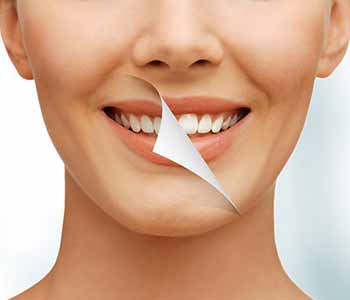No matter how smooth your skin, or what shade of lipstick you wear, dingy teeth add years to your look. White teeth radiate good health and youthfulness. Even with excellent oral hygiene, teeth can discolor over time. Fortunately, professional teeth bleaching brings back and even improves upon natural luster. Philadelphia dentist, Dr. A, shares this information to consider as you embark on the journey to a brighter smile.
How whitening works
Healthy teeth look and feel smooth, but enamel is actually porous, covered with microscopic openings, like pores in the skin. These tubules in tooth enamel absorb and hold pigments from anything dark colored that goes into the mouth – tea, coffee, red wine, berries, and tobacco.
Aggressive scrubbing may remove some surface stains, but it cannot reach into these tiny channels. Plus, abrasive brushing leaves scratches in tooth enamel that grab even more stains!
With professional bleaching, a prescription peroxide formula is applied to the teeth. In chemistry terms, peroxide is an “unstable element” made of two hydrogen atoms and two oxygen atoms per molecule. When exposed to air, it begins to oxidize or break down into the basic elements of water and oxygen. That process creates fizzing – oxygen bubbles rising to the surface.
During teeth bleaching treatment, the whitening agent flows into tubules, loosening pigments and pushing them out during oxidation.
Contact Us Today: (215) 624-1935
REQUEST AN APPOINTMENT
The method makes the difference
Over the counter, product uses the same basic ingredient as professional whitening – but in a much weaker strength. In an effort to achieve good results, some people are tempted to overuse retail whiteners, triggering sensitivity and risking harm to teeth and soft tissues.
Dr. A offers two whitening methods – at-home and in-office. In addition to a more effective chemical, professional results are largely a product of the delivery system – how the whitening agent is applied.
The doctor takes impressions of your mouth to create application trays with a true custom fit. With in-office treatment, a trained dental professional precisely applies whitening gel to tooth surfaces. These techniques ensure that each surface of every tooth (even teeth that are not straight) receives even coverage. One-size-fits-all strips, trays, and lights cannot provide this beautifully consistent color. You might compare it to attempting a tanned look from a spray can at home, compared to the even coverage of a professional airbrush tan.
Other tooth bleaching fast facts

- Teeth and gums must be healthy before whitening. Cavities and gum disease should be treated first.
- Properly administered whitening does not damage teeth. In fact, by cleaning out tubules, it encourages natural remineralization and hydration of enamel.
- The best time to whiten is just before bed. This timing reduces the opportunity for re-staining before natural remineralization can occur.
- Drugstore preparations and gadgets can be quite expensive. The cost of trial and error may quickly add up to the price of professional treatment.
- Sensitivity is normal. It can be genetic, triggered by minute cracks in enamel, or the result of dehydration temporarily reducing insulation around nerves. Dr. A can add a buffering ingredient to whitening gel to reduce sensitivity or adjust your at-home whitening schedule. He may also recommend post-whitening fluoride treatment.
- Professional laser or light whitening isn’t better (although it may be a little quicker). The initial dazzle of this method reverts somewhat as enamel rehydrates. There is no measurable whitening benefit beyond the first day or two and it increases the risk of sensitivity.
- One hundred percent of stains cannot be removed with one chair treatment. Some discoloration is the result of thinning enamel or internal stains from medications. That’s why Dr. A recommends continued whitening at home with custom fit trays. Once stains are resolved, it is easy to maintain brilliance with periodic re-treatment and good oral hygiene.
- Dental restorations do not respond to whitening chemicals. While whitening doesn’t hurt veneers, crowns, and white fillings, they won’t get any lighter. They can, however, be replaced with a lighter shade material to match whitened natural teeth.
Dr. A believes everyone deserves the confidence of a bright smile. His whitening for life program rewards good oral habits with complimentary bleach at regular checkups. Call (215) 624-1935 or use convenient online scheduling for teeth bleaching appointment at our Philadelphia office.


